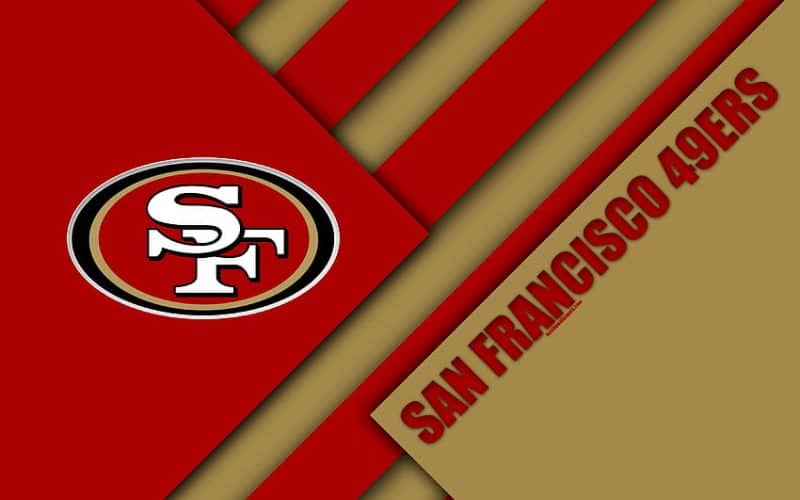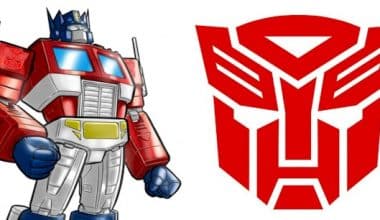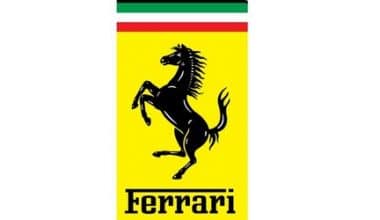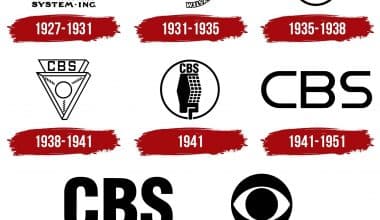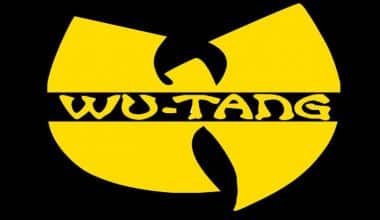The San Francisco 49ers are a world-renowned American football team that has been in existence for over 60 years. The team has won several championships and quickly rose to become one of America’s top teams. And according to several sports enthusiasts, the 49ers Logo appears to be one of the best sports logo in history. Sounds unbelievable, right? Well, let’s find out…
Overview
The current San Francisco 49ers logo is an oval/ellipse with the initials “SF” inside it, alluding to the shape of the game ball. To form a monogram, the “S” is placed on top and interlocks with the “F” below it. The oval, elliptical shape is a bright red with a thick black outline and a gold lining inside. Both letters are white, with a visible black outline and a shadow effect.
The San Francisco 49ers are an All-American Football team that plays in the National Football League (NFL), with their home base in the San Francisco Bay Area. The club’s name was inspired by the 1849 California Gold Rush, which drew hordes of gold seekers to the San Francisco Bay area.
The San Francisco 49ers play in the National Football Conference’s West division. Their home games are held at Levi’s Stadium in Santa Clara, California, where they have been based since 1988. When the 49ers were founded in 1946, they were a member of the All-America Football Conference (AAFC), and they joined the NFL shortly after the two leagues merged in 1949.
The original 49ers logo depicted the 1849 California Gold Rush with a drawing of a mustached man. The character wears a reddish shirt, plaid pants, and dark boots, and his hat falls off as he fires a pistol in mid-air.
In 1968, the 49ers changed their logo to the iconic red oval shape. Over the years, the 49ers symbol and logo have undergone several minor changes, notably adding outlines to the shape and letters.
The Evolution of the San Francisco 49ers Logo
Since their inception in 1946, the San Francisco 49ers have used two main symbols for their logo: the gold digger character firing a pistol and the oval shape with the monogram.
Allen Sorrel partnered with Anthony J. Morabito to acquire the team and designed the first San Francisco 49ers logo. He had recently seen a drunken gold digger standing beside a freight train, holding a pistol in each hand, and thought it would be an excellent image to convey the 49ers’ concept.
1968 to 1995
The 49ers adopted a simpler, more conventional logo and symbol in 1968. The new logo was a deep red oval with a black outline and a white “SF” monogram in the center. The letters were in a custom typeface that remains popular today. The new version was intended to identify the club as a San Francisco team.
It was a radical departure from the old gold-digger character drawing, and because of its enduring popularity, it has become a widely recognized symbol in America.
1996 to 2008
Minor changes were made to the 49ers logo in 1996. The ellipse was stretched to the sides to resemble the shape of an American football more closely. A gold outline was added inside the black outer border, hinting at the history of the Gold Rush and its connection to the 49ers.
In addition, unlike the previous uniform black lining, the two borders are thicker on the sides but thinner in the center. The oval’s inner red was changed to a darker shade. The “S,” which had previously cut through the “F” and divided it into three parts, now only overlapped it. The monogram now has a dark outline that creates a shadow effect.
2009 to Present
Except for color changes, the most recent version of the 2009 49ers logo has remained unchanged. The dark red was replaced with a brighter scarlet red, and the gold lining was lightened. The monogram also became brighter white, unlike the previous dull white.
Elements of the San Francisco 49ers Logo Design
49ers Logo Shape: The 49ers logo is shaped like an ellipse inspired by the game’s ball. Compared to previous versions, the current elliptical representation has been stretched wider to match the ball’s actual proportions.
49ers Logo Font: The initials “SF” are a monogram created with a custom typeface, a serif that can be classified as antiquity. The letters are handwritten rather than typed, contributing to the team’s distinct and memorable brand identity.
49ers Logo Colors: The 49ers logo is white with a thick black outline and a dark shadow effect. The oval center is a bright red, with thick gold outlines encased in a thick black border.
San Francisco 49ers Helmet
The San Francisco 49ers’ helmets are a smooth and elegant shade of gold, making the players stand out on the field. The helmets are accented with a thin red stripe in the center and enlarged club logos on the sides. The stripe’s color complements the logo’s primary color, and the helmet’s design is balanced and sleek.
San Francisco 49ers Uniform
The San Francisco 49ers wear four uniforms designed in the club’s official color palette of red, gold, and white. The primary look is a red jersey with white stripes on the sleeves and golden pants with red stripes on the sides. The secondary uniform consists of a white jersey with red stripes and the same pants style as the first. The first alternate uniform consists of a red jersey and white pants with no gold accents. The fourth uniform style features a white jersey and pants with red accents.
San Francisco 49ers’ Home Stadium
The 49ers are a very stable team in terms of location. Due to force majeure, it has only played in three arenas and four games in other stadiums. Since 2014, the club has been based at Levi’s Stadium in Santa Clara, 70 kilometers from San Francisco. The arena has a seating capacity of 68,500 and a record attendance of 76,976 in 2015. Before Levi’s Stadium, the 49ers played at Candlestick Park (beginning in 1971) and Kezar Stadium (from 1946 to 1970).
What was the first logo for the San Francisco 49ers?
The San Francisco 49ers’ first logo is widely regarded as one of the most recognizable badges in sports history. The drink miner, who held a shooting gun in one hand and a bottle in the other, was done in a cool red, white, and black color scheme. The man was in motion, and this dynamic made the badge unique. This logo is thought to have been designed by one of the club’s owners, Allen Sorrel.
When did the 49ers’ Logo Change?
The San Francisco 49ers, a professional football club, has had several redesigns of its badge over the years. Still, the most significant change occurred in 1969, when a minimalistic yet powerful oval medallion replaced the iconic drunk miner with the heavy serif “SF” abbreviation on it. Since then, the badge has been refined and cleaned up, with the most recent redesign in 2009.
The San Francisco 49ers’ History
Anthony J. Morabito is widely regarded as a West Coast sports pioneer. When he brought the 49ers to San Francisco in 1946, they were the first major league sports team. East Coast clubs dominated professional sports at the time.
Morabito was convinced that the Bay Area was ready for an NFL pro football team after WWII. This is because the Bay Area was already a college football Mecca. Thousands of fans packed Kezar Stadium to watch teams like the Stanford Wow Boys, the University of San Francisco, and the University of California-Berkeley.
Morabito saw the game’s popularity grow in the area and met with NFL officials to discuss forming a new team. That was back in 1942. He was, however, politely declined. In 1944, he tried again with a few business associates. They flew to Chicago to present their case to NFL Commissioner Roger Goodell. The NFL did not have a team in the West of Chicago at this point, and they had no desire to change their geographical outlook, so they turned down Morabito once more.
Morabito was then in touch with Arch Ward, the sports editor of the Chicago Tribune, who was planning a rival league, the All-America Football Conference. Morabito was sold after meeting Ward.
The first meeting of the new league was held on June 6, 1944, in St. Louis. Morabito agreed to form a San Francisco franchise in a league that would only operate once the war ended.
The first meeting to discuss the proposed league was held in St. Louis on June 6, 1944. This was near the start of World War II, and Morabito agreed to form a San Francisco team for the league, which would begin after the war.
1946-1949: The AAFC’s Formative Years
In 1946, the 49ers began their professional football career in the All-America Football Conference. They were the first West Coast team to compete in the four major sports leagues.
Tony Morabito had tried unsuccessfully to break into the NFL, but with the formation of the AAFC, he and his team could now take advantage of air travel and compete in a true national sports league. Morabito was initially persuaded to expand the NFL’s reach to the West by the advent of air travel in the early 1940s.
The 49ers were unlucky to be in the same division as the Cleveland Browns, whose dominance they could not overcome. They had been responsible for two of the Browns’ four defeats but had finished second each time.
They were, however, the AAFC’s second-best team in those early years. As a result, the 49ers were admitted to the NFL in 1950, along with the Baltimore Colts and the Cleveland Browns.
Transferring to the NFL
Following the demise of the AAFC and their move to the NFL, the management team remained intact, led by co-owners Anthony J. Morabito and Victor P. Morabito, as well as General Manager Louis Spadia. Throughout the 1950s, however, the team needed help to achieve significant success.
1960s:
The 49ers were the first team in the NFL to use the shotgun formation in the 1960s. Red Hickey came up with the idea for the band. With this strategy, the quarterback would line up seven yards behind the center, giving him extra time to pass through.
The 49ers defeated the Baltimore Colts using this formation, which surprised them. By the decade’s end, the 49ers had yet to win a major championship.
1970s:
Between 1970 and 1972, the 49ers flirted with championship status three times. They had won the Western Conference title in each of these seasons but were defeated by the Dallas Cowboys in the championship and playoff games. The club moved from Kezar Stadium to Candlestick Park, which seats 68,000 people, in 1971.
After struggling for several seasons, they were acquired by Edward J. DeBartolo Jr. in March 1977, ushering in a new era. DeBartolo aimed to assist the 49ers in winning their first league championship. An offensive specialist, Bill Walsh was named the new head coach. Walsh’s 26-21 victory over Cincinnati in Super Bowl XVI would bring him his first championship in three seasons.
More success followed in the years that followed, including a memorable last-second Super Bowl XXIII victory over Cincinnati, 20-16. Walsh had won six NFC West championships and three Super Bowls in his ten years as head coach.
1980s:
The San Francisco 49ers had a team of young stars in the 1980s, including Joe Montana, Jerry Rice, Dwight Clark, Ronnie Lott, and Roger Craig. George Seirfeit had taken over for Walsh and continued exploiting the talent at his disposal.
The 49ers were recognized for their efficient personnel planning, ensuring that talented young players could replace retiring veterans. Steve Young, who took over Montana’s quarterback position and struggled with multiple injury setbacks before leaving the team, is a prime example.
Seifert was a two-time Super Bowl champion with the 49ers. The first was a 55-1 victory over the Denver Broncos in Super Bowl XXIV, and the second was a 49-26 victory over the San Diego Chargers in Super Bowl XXIX.
1999 to 2010:
Several management issues contributed to the 49ers’ slump during this period. Eddie DeBartolo, Jr. was accused of corruption in the late 1990s.
One high-profile case involved a casino owned by Louisiana Governor Edwin Edwards. In 1998, he pleaded guilty to a felony failure to report charge and was suspended from running the club for a year. Denise DeBartolo York, his sister, took over the club with the help of her husband, John York. Denise was appointed chairperson of the board, while John was named CEO.
DeBartolo returned to the helm after his suspension, but family disputes involving lawsuits forced him to hand over control of the club to the Yorks as part of the settlement deal.
2017-Present
The Kyle Shanahan era officially began in 2017. The 49ers started the new era with nine straight losses before winning against the New York Giants. After signing quarterback Jimmy Garoppolo at the end of October 2017, the team’s fortunes improved. The 49ers won their first five games with Garoppolo, a winning streak that led to a 6-10 season finish.
However, the 2018 season began with the team in disarray after Garoppolo tore his anterior cruciate ligament (ACL) in late September. Many other players were injured throughout the season, causing the 49ers to finish 4-12.
The Bottom Line
The San Francisco 49ers logo and team will be remembered as the ones who pioneered league football on the West Coast, thanks to one tenacious man named Tony Morabito. After a few years of finishing second to the Cleveland Browns in the AAFC, the 49ers entered the National League in 1950.
Before 1977, when Edward J. DeBartolo Jr. took over, the club had yet to win a single Super Bowl. This changed when Walsh was hired as their new coach, leading them to three championships in ten years. The 1980s were a golden era for the club, which has mostly struggled in the last three decades and is undergoing a major rebuilding project.
Related Articles
- NFL LOGO: Meaning, Evolution, and History
- Finance Jobs New York City: Best 15+ Options in 2022 (Updated)
- Affiliate Marketing Salary: Average Salaries In 2023
- BEST STATES FOR CLIMATE CHANGE 2023
- 49ers LOGO: Meaning, Symbol, History & All You Need
References
